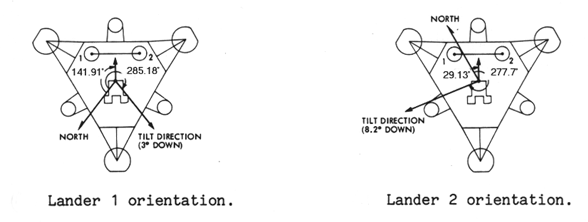 |
 |
Mike Caplinger, Malin Space Science Systems March 1994
Two Viking spacecraft landed on Mars in 1976, Viking Lander 1 on July 20th and Viking Lander 2 on September 3rd. Each lander carried three instruments designed to search for life on Mars, a sensitive device to measure minute amounts of gases found in the atmosphere and soil, a meteorology experiment to measure atmospheric temperature and pressure as well as wind speed and direction, an instrument to determine the abundance of mineral-forming atoms in the soil, a seismometer to look for "marsquakes", and a pair of panoramic scanning cameras that returned many images of the surface.
Here's the view from Viking Lander 1 (Mutch Memorial Station) on Chryse Planitia at 22.5 N, 48 W. Taken by camera 1, the center of this image is looking roughly southeast, and the image covers about 120 degrees. You can tell by the shadows that this image was taken during the early morning. Click on the image to see an enlarged view of the center section. The horizon near the center is about 75 m (about 250 feet) away and about 5 m (about 16.4 feet) higher than the lander. The boulders on the "skyline" are 4 m (about 13 feet) across. The Viking images are more foreshortened than they appear. The dark trench at the left side of the image is 3 m (10 feet) away and 40 cm (about 16 inches) long. The rock to its right (also seen in the enlarged view at the lower left) is only 20 cm (about 8 inches) across.
Here are the 315-degree morning views from the two cameras of Viking Lander 2 on Utopia Planitia at 48N, 226W:
Camera 1 -- center roughly west

Camera 2 -- center roughly east

Note that these images have been geometrically corrected so the horizon is level; Viking Lander 2 is tilted about 8 degrees from the vertical because one of its footpads is resting on a rock, and raw frames from Viking Lander 2 have a curved horizon for this reason.
Using images from both cameras, we can create stereo pairs (view this using a pair of red/blue glasses with the red filter in front of your LEFT eye.) These images are from Viking Lander 2, looking roughly north:
Note that Viking Lander stereo is notoriously difficult to fuse because of the long camera baseline; look at the left side of the image near the horizon, and try to focus on infinity. Don't get frustrated if you are unable to fuse the images. You can click on the image above to get a full-resolution red/blue stereo view (stored as a 680K GIF image because JPEG doesn't do a good job on these images.)
Here are the left and right images in gray level form (click on each image to get full resolution):
This diagram shows the orientation of the two landers:

Viking Lander 1 has been renamed the Mutch Memorial Station in honor of Tim Mutch, the Team Leader of the Viking Lander Imaging Team, who was killed in a climbing accident in Nepal in 1980. Mutch and his colleagues on the Viking Lander Imaging Team wrote an extremely good description of the Viking lander mission, with extensive illustrations including stereo pairs, called The Martian Landscape, published as a NASA Special Publication (NASA SP-425); it is available in most libraries and can be purchased from the U. S. Government Printing Office.
Mike Caplinger (mc@msss.com)